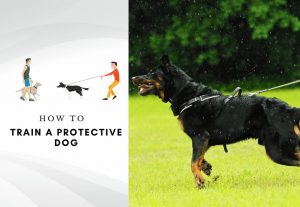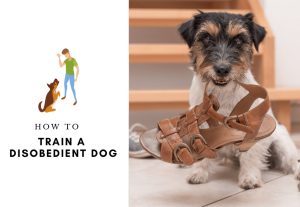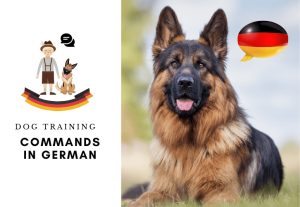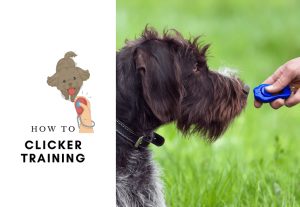You don’t need to be a training expert to learn how to train a protective dog. There are some useful steps and strategies which you can imply to get the work done.
These strategies require your passion, confidence, and love towards your best pal.
The information in this article has been taken from various valid sources who have spent their time and resources to come up with solutions and identifications of the problem.
The information from these valid and authentic sources with scientifically proven research will prove fruitful.
Here you will learn about:
- Signs a dog is protective
- Reasons dogs become overprotective
- Difference between protective & aggressive dog
- How to Train an Overprotective Dog
- The Gradual Introduction Method
- The Perception Method
Let’s get started.
5 Signs Your Dog Is Protective Over You

A dog uses its entire body to communicate, and when it’s about communicating with the owner, every body part counts.
However, the behavioral responses and cures are different for dogs from various breeds and different environments.
But still, there are some common indicators that help dog owners to comprehend what their best buddy wants to tell them.
The following signs will let you understand and realize that your dog is protective, and you need to start son an overprotective dog training.
1. Excitement on Hearing Keeper’s Name
Dogs can identify and understand words. When you are providing them training, you use particular words and sounds to make them perform different acts.
The same goes for the name of the owner. When a dog has developed a strong association with the owner, they will show excitement on hearing the name.
This excitement indicates that the dog has become possessive and protective of the keeper or the owner. And now, there will be a behavioral change that will make you suffer in some way or the other.
2. Guarding Behavior
It will make you feel special when your dog guards you in some way when you sit at the table to eat with people or trying to spend some relaxing time.
If in situations like these, your dog tries to guard you and stays vigilant, these are the things to worry about instead.
This protective behavior will create future issues, and your dog will suffer because of the newly developed protective instinct for the owner.
3. Personal Items Are Only Accessible to Keeper
Your dog brings toys and items for you to play with is not an issue at all. Also, when your canine buddy brings you other items, this is a sign of trust and love.
For most people, this act is a sign of a strong relationship. But when the dog brings items (only to you) and whines afterward, this is the starting of protective behavior.
When your dog has started to bring the broken item, he or she is showing belief in your intelligence.
Your dog trusts you that you will repair the damaged or broken thing, and you are the only person in their life to do that.
That’s why you need protection as you are more important than any person.
4. Constant Eye Contact
Researchers have found that when dogs show constant eye contact with the owner, they feel a surge of oxytocin.
This continuous eye contact makes them feel more affectionate towards the keeper.
Your best buddy will also make eye contact with the strangers, but there will be no oxytocin this time. When eyebrows are raised, the stranger will have to bear the wrath of the canine.
But for the owner, the constant eye contact more frequently will make the dog protective towards the keeper or the owner, and there will be some consequences.
5. Sitting Near Keeper’s Feet
This is the ultimate sign of protecting a dog when the usual place for sitting is the keeper’s feet.
When your dog unusually sits near, and on your feet, this is the message that you are under guard and protection for other people.
This sign is alarming for the owners as it will make the dog overprotective. You will have to bear brawls, barking, and fights with strangers and other dogs afterward.
4 Reasons Dogs Become Overprotective
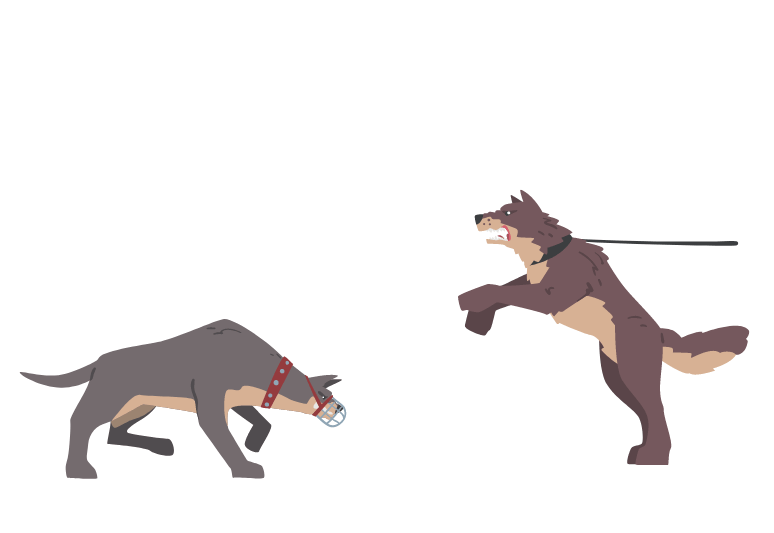
No other pet can be called a best friend of a man than the dog. These best friends are loyal and sincere to their owners by all means. They don’t give it a second thought to lay their life for their owner and family.
There are various stories and news when a pooch lays life to protect its owner and family from imminent danger or a ferocious beast.
The protection and guarding behavior can go to a whole new level that could cause issues and problems for the keeper and other people around.
There are various reasons for the enhanced overprotective behavior. The most common ones are as follow:
1. Family
Dogs are descendants of wolves who are intelligent and protective towards their families. When man domesticated these canines, they gave food and affection to these creatures.
These dogs, in turn, accepted human keepers as their family and started protecting them as they would do for their own.
The same behavior is still present in all the pooches, and you will see that they will respond to everything furiously, which seems dangerous to them for their family.
When a stranger or some animal is posing a threat to the children or family of the owner, dogs will react immediately. They will protect their family at all costs, and this instinctive behavior will make them overprotective.
2. Good Treatment
You can consider that a dog knows that any harm to the owner will put food and shelter at risk. But still, this beautiful creature loves the owner unconditionally.
Their loyalty and sincerity make them protective towards the owner, their children, and the better half. Your dog will also protect your property and animals if you have one.
When you give good treatment to your canine buddy, you will get love, affection, and protection from them. Dogs have protective instincts, and they will use them to guard you and your belongings when you treat them well.
3. Previous Abuse
If you have a dog that you obtained from a shelter or another owner, there are high chances that you will face behavioral issues.
If your dog has suffered abuse from the previous owner or suffered some severe conditions before reaching the shelter, some bad memories are imprinted on the mind.
These bad memories will force the dog to be overprotective and show signs of agitation and stress all the time.
4. Encouragement
People unknowingly encourage negative behavior in their dogs. The most common negative behavior endorsement can be seen on walks and in parks.
When your dog sees a stranger and barks at him, and you do nothing. This is the sign for your dog that it is an approval for doing the same for next time.
Now your dog will charge on every stranger that will come forth. The running sprees behind every moving thing should also be stopped right away.
But always beware of punishment to your best friend. Punishment will also encourage protective behavior for the dog and you.
Difference Between Protective & Aggressive Dog

There is a slight difference between a protective and aggressive dog, but you need overprotective dog training in any way.
Sometimes you will see both the tendencies in your best buddy but most of the time, you can tell with the acts and behavior of the dog around the owner and children.
To completely understand the difference between aggressive and protective dogs, let’s break down these two and discuss them separately.
Protective Dog
A protective dog is ready to attack if there is an intimate danger. Your dog will sit in a sharp posture but will remain calm if there is no danger around. The protective behavior will make your dog sensitive and attentive towards the changing stimulus in the environment.
You can tell your dog is overprotective if your best friend keeps eyes on you all the time.
Dogs are protective for the owners when they sit near the person on and around the feet and become highly attentive to any sound or changing scenario. New people and the animal will make them stand on their feet and be ready to charge.
You can tell the difference between aggression and overprotection by simply one thing.
If your dog is attentive towards the external environment and keeping a vigilant eye on the owner with a calm disposition, he is protective. And if your dog is charging and barking towards everything around with dilated pupils and ready to attack posture, this is aggression.
Aggressive Dog
As discussed above, an aggressive dog doesn’t need any specific stimulus to come to a charging posture. An aggressive dog will never be able to sit relaxed, even in a sharp posture. When the overprotective feeling crosses the threshold, the dog starts behaving like an aggressive dog.
Mostly the dogs become aggressive for your children or their children. If a female dog has trust issues or history, she will be more aggressive around the pups or when someone is around. When your dog has a history of abusive behavior from the owner, the aggression will be evident.
The continuous barking and charging on everything around will make you realize that your dog is showing aggression. And the dilated pupils with excessive barking will force you to train them and use different products to curb this behavior.
How to Train an Overprotective Dog
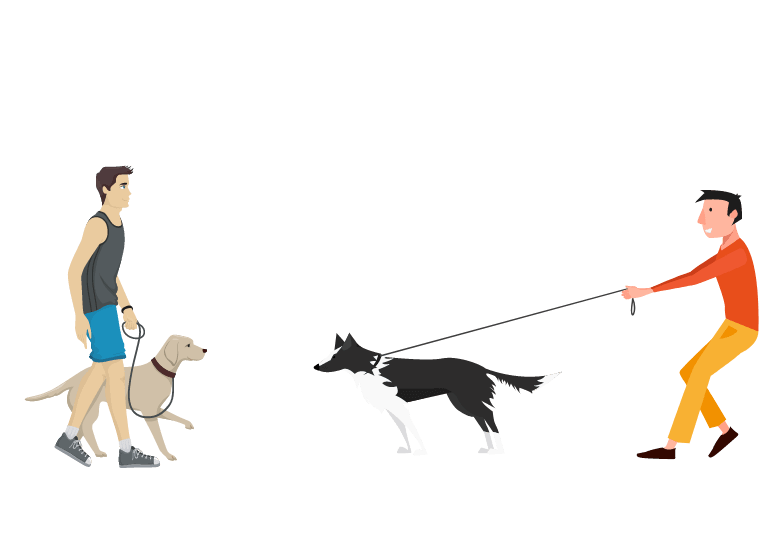
If you have realized that you are living with an overprotective dog, you are on the brink of a long process of rectification.
You can’t change your dog in one day, and you will need a mix of strategies and procedures to get the job done.
This behavior change might take a month or two or more to rectify, depending on your dog and surrounding factors.
How to train a protective dog is not a tricky question, and the process might stretch a little. But in the meantime, if you are expecting guests or you have to take your dog out, you can still get it done.
Some products can help you manage overprotective and even aggressive behavior right away.
These products help you take control of your dog and protect others from the spontaneous behavior of your overprotective dog.
Leash
- Pulling dog leash no more leashburn! Our padded handle training leash wont dig into your hands, so you can maintain a firm grip even when your dog starts to pull hard.
- Patented design gives confidence - Dual handle dog leash features non-bending traffic handle 18 inches from the clip and a padded handle at the end; hold both for control or grab the end to give more freedom.
- Maximum control and confidence not too long, not too short. Our customers agree - This is the best dog leash for large dogs. Purposefully designed at 5 feet in length by 1 inch wide with handle at 18 inches.
- Ultra strong construction assembled in the USA - Heavy duty dog leash is crafted out of durable nylon and is hand made in Southern California.
- 5 year manufacturers warranty - Leashboss products automatically come with The Boss Promise, a 5 year manufacturers warranty that protects against defects, product issues, and chewed leashes. This product is PATENTED.
Prices pulled from the Amazon Product Advertising API on:
Product prices and availability are accurate as of the date/time indicated and are subject to change. Any price and availability information displayed on [relevant Amazon Site(s), as applicable] at the time of purchase will apply to the purchase of this product.
If you are expecting guests in your house, you can keep your dog on a leash. A leap training leash will help you control the action of your dog when there are new people around your overprotective buddy.
The leash will also help you make others comfortable in Dog Park or other places. A dog on the leash will start to learn how to behave properly.
Various types and kinds of leashes are available, but nylon is the most durable and sturdy material.
The Leash boss nylon leash will offer you a powerful pull against the complete weight of a large dog. And it will withstand the pressure as well.
Muzzle
- SOFT & LIGHTWEIGHT rubber basket design gives all-around mouth protection allowing canines unrestricted eating, drinking and panting while preventing biting. Used for safe socialization, safe handling during vet visits, grooming or dog travelling.
- SAFE & SECURE ergonomically designed safety strapping ensures muzzle will remain securely in place and features two attachment points using an attachment loop designed to attach to your dog’s regular collar and an optional, removable over-head safety strap
- ADJUSTABLE & COMFORTABLE Neoprene padded lining for added comfort and fully adjustable neck and head straps with pre-holed webbing for a quick and secure fit.
- DOG FRIENDLY – allows canines to drink, pant and be rewarded and treated. Perfect for daily dog exercise and walks
- EXTREMELY TOUGH AND DURABLE made of a malleable thermal plastic rubber which can be heated and shaped for a personalized tailored fit around dog’s snout, including broad nosed dogs. Gives all around protection for biting or snappy dogs.
Prices pulled from the Amazon Product Advertising API on:
Product prices and availability are accurate as of the date/time indicated and are subject to change. Any price and availability information displayed on [relevant Amazon Site(s), as applicable] at the time of purchase will apply to the purchase of this product.
For a muzzle, spend some time creating a positive association. And use the most comfortable product for your best buddy. The muzzle will reduce the chances of bite risk and keep people safe.
An overprotective and aggressive dog must be kept on a sturdy muzzle all the time. An overprotective dog can bite if it misjudges the person as an imminent threat.
The dog’s protective instincts will force the poor soul to bite the person coming or running towards you. And the muzzle is the ultimate protection for people from razor-sharp canine teeth.
Protective Dog Training Methods
The two most common training methods allow you to make your overprotective buddy normal and happy.
These methods are different in approach, and you can choose them according to your needs and requirements for your dog.
Every method is a definite success, and you can choose it to get more out of your relationship with your charming pooch.
1. The Gradual Introduction Method
This method is used with the help of new pets and/or new people. When you want your dog to remain calm and comfortable around new people and pets, this method gradually helps you attain good results.
STEP 1: Move Towards The Perceived Threat
Put the leash and muzzle on your best friend and approach very slowly the the person and/or pet you chose as the test subject. If you go towards the person by yourself, your dog will consider them less threatening as you approach them. Keep the dog as close to you as possible and hold the leash tight.
STEP 2: Appreciate The Right Behavior
When you see that your dog is comfortable in their presence, start appreciating the dog or this better behavior. Keep patting the dog or say good boy for this positive behavior. You can also offer treats to make them realize that this is the desired behavior you want them to exhibit.
STEP 3: Pull Him Away if Things Go Wrong
If your dog starts showing agitation or tries to charge on the person or pet, use force to keep him down. Pull him away and start going away from the person or the pet. You should go 10 to 15 feet away from them.
STEP 4: Make Them Calm
Once you are far from the “threat”, make your dog calm by making him sit. Then ask your dog to wait and position yourself between you and the dog. After that, gradually approach them again and appreciates the dog if he shows calm behavior.
STEP 5: Repeat The Process
You need to repeat the process from step 1 onward to infuse this behavior in your canine. When the positive reinforcement and treats have started showing their magic, you will see a dramatic change in the overprotective behavior of your dog.
2. The Perception Method
This is the method that changes the perception of both the owner and the dog.
STEP 1: Be a Pack Leader
When you have secured the dog on a leash and are outside, you should focus on the perception of your best buddy. Secure the leash, and when someone is approaching you, you must stand before the doge. When you are standing between the stranger and your dog, you are behaving like a pack leader. This way, your dog will understand that you will protect him from danger.
STEP 2: Be Confident
Your dog will imitate your behavioral response when you are outside, or someone approaches you. If you are agitated or confused, the dog will show the same behavioral response. This confusion will turn into agitation, and there are high chances your dog will charge upon the stranger.
STEP 3: Shout if Dog Barks
Even if you remain calm and confident, there are still chances that your dog will bark. If he does so, shout no in a stern voice. Don’t make your dog frightened but still let him know that you are serious about it. Say no and pull the leash with a tug to make the dog understand that this behavior is not welcomed.
STEP 4: Teach Your Dog to Follow Obedience Commands
You must make the dog follow your commands. If you are teaching him to sit and stand on your command, you are endorsing that you are the pack leader, the one in charge. This obedience training process will bear fruits in real scenarios where you can control the overprotective dog from barking and running behind other people and pets.
STEP 5: Endorse Your Authority
Make him realize that you are the boss and leader in this intimate relationship. Wait for a little and make your dog wait before offering the food. When you are going out, make them understand that you are a pack leader by making them wait and follow your commands.
This change in perception will make things work for you and the dog to eradicate overprotective feelings.
FAQs

How to Socialize an Overprotective Dog?
Use the perception method that we have discussed above to make them socialize with new people and pets or work with a professional.
How Do I Make My Dog Less Protective?
Keep him on a leash and always stand between the dog and the coming stimulus. This will make them believe that you are the pack leader and will tackle the threat and danger.
What Are The Most Protective Dog Breeds?
The most protective dog breeds are Belgian Malinois, German Shepherds, Bullmastiff, Giant Schnauzer, Rottweilers, Doberman, Pinscher.
Conclusion
Before coming to the question of how to train a protective dog, you might have suffered a lot in various ways. We hope that you have realized the gravity of the situation before things could go wrong.
You must have a training leash and a muzzle to keep your dog and everyone around safe from your overprotective buddy.
The training methods I’ve listed for you in this guide are a guaranteed success for keeping your best friend happy and safe for strangers and your family members.
That being said, there is nothing left but to thank you for your attention up to this point.
I hope I have been helpful, and I wish you many moments of joy and satisfaction in the company of your beloved puppy.
Of course, if you have any questions or concerns along the way don’t hesitate to contact me.
Thank you for reading and have a great day!
Until next time!
A big hug.
Read also:

